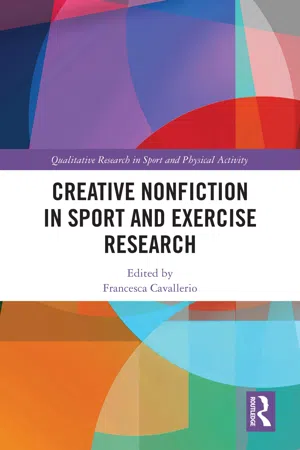
Creative Nonfiction in Sport and Exercise Research
Francesca Cavallerio, Francesca Cavallerio
- 208 páginas
- English
- ePUB (apto para móviles)
- Disponible en iOS y Android
Creative Nonfiction in Sport and Exercise Research
Francesca Cavallerio, Francesca Cavallerio
Información del libro
Academics around the world recognise the effectiveness of storytelling as a way to engage audiences in conversations, raising awareness of issues, and encouraging change. Stories are now seen as the best medium to convey information to diverse audiences.
This book explores a novel approach to representing research findings through the adoption of creative nonfictional stories (CNF). At a time when dissemination of scientific research is constantly highlighted as a fundamental aspect for academics, CNF represents an opportunity to effectively communicate science to non-academic audiences through stories.
By providing practical examples of how to transform findings into compelling stories rooted in data, following the mantra of showing rather than telling, which characterises CNF, Creative Nonfiction in Sport and Exercise Research helps researchers – qualitative, quantitative, established professors, and students – to turn their research into stories.
A unique contribution to the field, this book is the first in the sport and exercise research field to take scholars on a discovery jouney, moving from their classic realist to a more creative, compelling, but still rigorous representation of research findings. The book features chapters written by authors from different sport research backgrounds, who present the findings of a previously published 'classic' study rewritten in the form of a story. Reflective chapters focusing on the how-to and the challenges of this creative analytical practice complete the work, to support scholars in developing their creative skills.
Preguntas frecuentes
Información
Part I Learning the Craft of Creative Nonfiction
1 ‘Where Do I Start?’ Getting to Grips with Creative Nonfiction
Show Rather Than Tell
It all began playing in the back garden when I was really young, almost as soon as I could stand up by myself, I would be holding a bat. I was always throwing and hitting balls around and quickly I grew attached. I developed a real passion for cricket, my parents took me down to the local cricket club and I started playing and making friends until eventually the club became my second home. Colts cricket really starts around the age of 11 where you begin to play with a hard ball, you’re playing for club, at school and if you are chosen to, you even get the opportunity to be involved with a representative side.[…]The men’s leagues were a lot bigger in terms of geographical location. I was familiar with travelling a bit with my county in the age groups but that was with parents, driving yourself is a whole different ball game and the cricket itself a whole new ballpark. It was no longer a pleasant environment. To gain an understanding of how much teams wanted to win you only need to know how much some players are being paid. Along with this comes peer pressure, peer pressure from team mates to play week-in-week-out and if you don’t, well you better have had a great excuse for not playing because you’d know about it on return […].1
As the play begins, it is raining quite heavily. Mag Folan, a stoutish woman in her early seventies with short, tightly permed grey hair and a mouth that gapes slightly, is sitting in the rocking chair, staring off into space. Her left hand is somewhat more shrivelled and red than her right. The front door opens and her daughter, Maureen, a plain, slim woman of about forty, enters carrying shopping and goes through to the kitchen.Mag: Wet, Maureen?Maureen: Of course wet.Mag: Oh-h.Maureen: takes her coat off, sighing, and starts putting the shopping away.Mag: I did take me Complan.Maureen: So you can get it yourself so.Mag: I can. (Pause.) Although lumpy it was, Maureen.Maureen: Well, can I help lumpy?Mag: No.The Beauty Queen of Leenane2I stop reading. And start again. I take in these few lines, the scarce words. And realise how much of the characters they allowed me to discover already.Incredible.My eyes keep scanning the text, back and forth, back and forth. I think this is it! I think I finally get what ‘show rather than tell’ means!
Layering
Índice
- Cover
- Half Title
- Series Page
- Title Page
- Copyright Page
- Dedication Page
- Table of Contents
- List of Figures
- List of Contributors
- Foreword
- Acknowledgements
- Introduction
- Part I Learning the Craft of Creative Nonfiction
- Part II From Realist Tales to Creative Nonfiction
- Part III Moving Beyond “Just” Creative Nonfiction
- Index